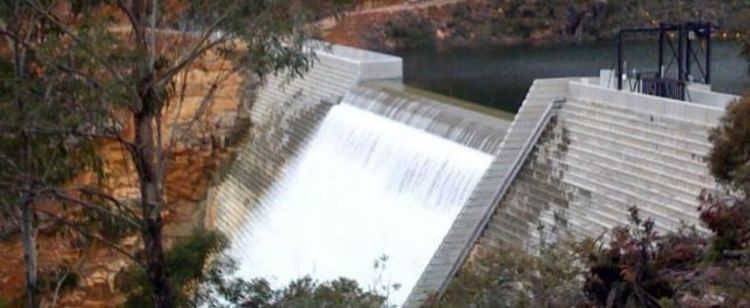Country Australia Height 50 m Surface area 45 ha Construction cost 24 million AUD | Status Operational Catchment area 163 km² Spillway 1 | |
 | ||
Opening date November 2007 (2007-11) Owner(s) Tasmanian Irrigation (TI) Pty Ltd Similar Nieterana Power Station, Liapootah Power Station, Meadowbank Power Station, Wayatinah Power Station, Poatina Power Station | ||
Meander dam
The Meander Dam is a concrete gravity dam across the Upper Meander River, located in northern Tasmania, Australia. The impounded reservoir is called Lake Huntsman.
Contents
- Meander dam
- Flyer claiming meander dam could collapse panics niles residents
- Features and location
- Power plant
- References
The dam was constructed in 2006 by the Tasmanian Rivers & Water Supply Commission for the principal purpose of delivering a reliable supply of irrigation water to the Meander Valley, estimated at 44,200 hectares (109,000 acres). Adjacent to the dam is a small conventional hydroelectric power station.
Flyer claiming meander dam could collapse panics niles residents
Features and location
Proposals to build a dam on the Meander River below Warners Creek date back to at least 1968. The site was cleared in preparation for dam construction during the last 1980s. In 1995 a report by engineering consultants, GHD Group, stated that the lack of a reliable water supply for irrigation in the Meander Catchment is seen as a key factor limiting potential future expansion of agricultural enterprises. The pressure on water resources in the Meander Catchment resulted in the need to limit and sometimes prohibit the extraction of water from the river during the irrigation season. In 2002, a water management plan for the catchment was under development and was expected to address environmental flow concerns through the implementation of higher minimum river flows. This increase in minimum flows would result in the need to reduce the irrigation water currently extracted from the river, which would reduce agricultural production and prevent the development of water dependent agricultural enterprises.
However, the dam faced considerable opposition. Despite being passed by two other statutory committees of the Tasmanian Parliament, the Resource Management and Planning Appeal Tribunal knocked it back on economic and environmental grounds. The Tribunal vetoed the construction of the dam because it could not determine its economic value - as estimates ranged from a loss of A$600,000 to nearly A$40 million - and because it would affect two threatened species the epacris plant and the spotted tail quoll. In September 2003, following intervention by the Australian Government, the project was approved.
The Meander Dam wall, constructed with 85 thousand cubic metres (3.0×10^6 cu ft) of concrete, the gravity dam is 50 metres (160 ft) high and 170 metres (560 ft) long. At 100% capacity the dam wall holds back 43,000 megalitres (1,500×10^6 cu ft) of water. The surface area of Lake Huntsman is 45.3 hectares (112 acres) and the catchment area is 163 square kilometres (63 sq mi). The single uncontrolled centrally located conventional spillway is 28 metres (92 ft) wide with four off Flowgate spillway gates.
Since completing the construction of the Meander Dam a further four pump and pipeline schemes have been built to expand the reach of the water available from the dam and deliver irrigation water to the adjoining farming districts of Caveside-Dairy Plains, Rubicon River, Quamby Brook and Hagley.
Power plant
The Lake Huntsman Power Station has one unique double Francis-type turbine, with a generating capacity of 1.95 megawatts (2,610 hp) of electricity. The Meander Dam, which creates Huntsman Lake and supplies the power station with water was completed in November 2007. The power station was commissioned in February 2008 by Tyco Tamar. Electric power generation is a by-product of water released to primarily satisfy irrigation purposes.
